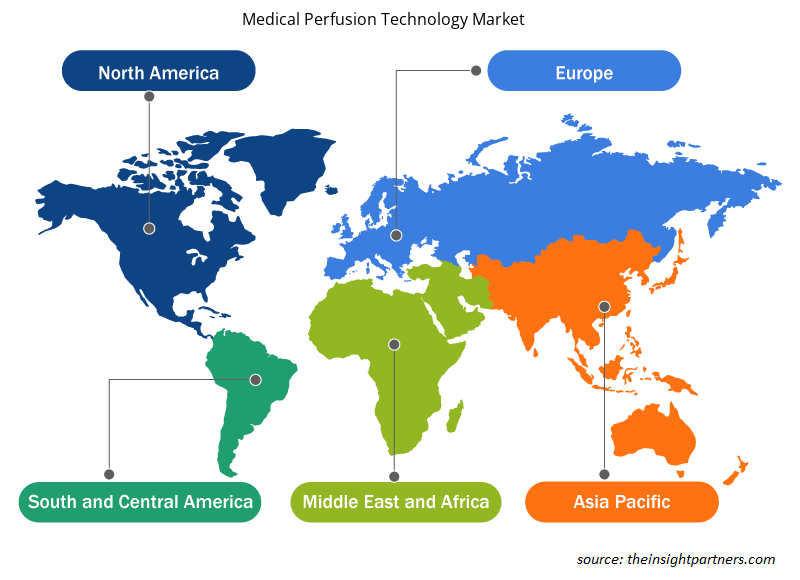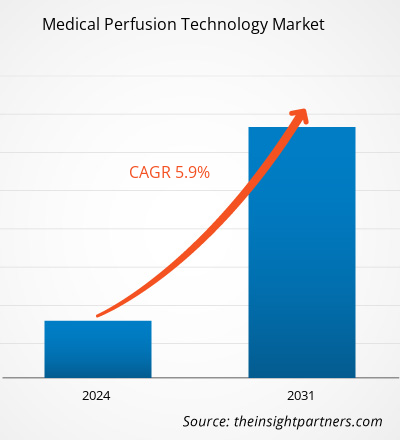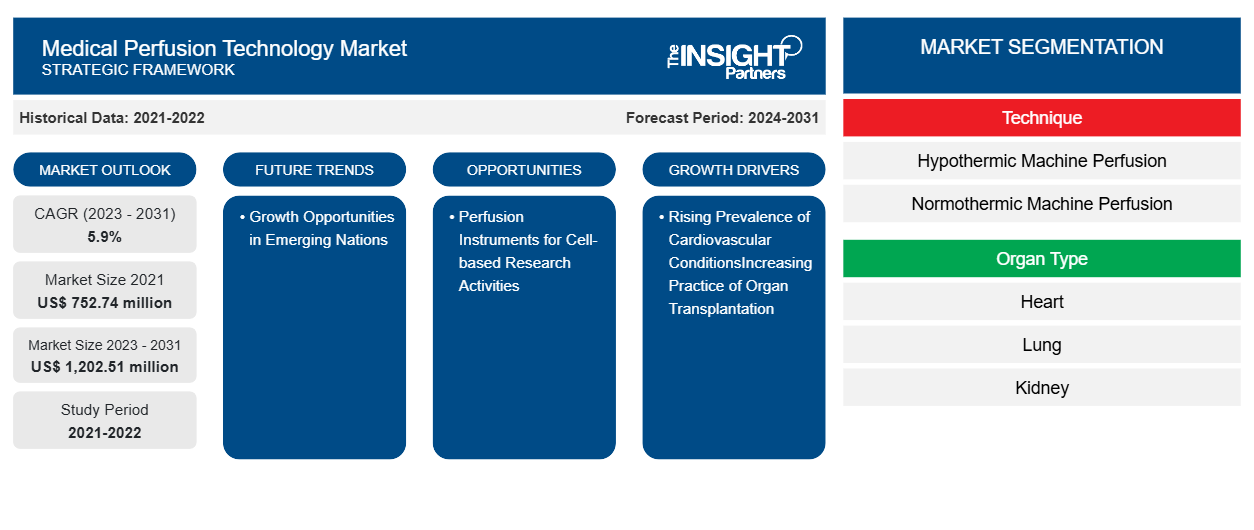La taille du marché des technologies de perfusion médicale en 2021 s'élevait à 752,74 millions USD et devrait atteindre 1 202,51 millions USD d'ici 2031, contre XX millions USD en 2023. Le marché devrait enregistrer un TCAC de 5,9 % en 2023-2031. Les instruments de perfusion pour les activités de recherche cellulaire et l'adoption de machines de perfusion compactes et portables devraient rester les principales tendances du marché des technologies de perfusion médicale.
Analyse du marché des technologies de perfusion médicale
La prévalence croissante des maladies cardiaques telles que les maladies coronariennes, les maladies cardiovasculaires, les maladies cérébrovasculaires et les maladies cardiaques rhumatismales, ainsi que la croissance significative des sociétés biotechnologiques et pharmaceutiques, l'augmentation des activités de recherche sur les cellules et la pratique de la transplantation d'organes contribuent tous à la croissance du marché des technologies de perfusion médicale. En outre, le secteur des soins de santé bien établi, les investissements accrus des principaux acteurs et les tentatives du gouvernement pour développer le secteur des soins de santé devraient tous alimenter la croissance du marché.
Aperçu du marché des technologies de perfusion médicale
Les États-Unis devraient être le plus grand marché pour la technologie de perfusion médicale, ce marché étant attribué à de multiples facteurs tels que l'augmentation des maladies cardiovasculaires, la recherche clinique complète, la recherche contractuelle, etc. De plus, en termes de technologie, la nation est bien en avance sur les autres pays développés et émergents. Les progrès technologiques ont permis le développement de diverses technologies de perfusion médicale et de technologies utilisées pour leurs applications. Les maladies cardiaques sont la première cause de décès aux États-Unis. Les maladies coronariennes surviennent lorsque les artères du cœur sont incapables de fournir suffisamment de sang riche en oxygène au cœur. Selon le CDC, le type de maladie cardiaque le plus fréquent est la maladie coronarienne (MC). En 2021, environ 375 000 personnes sont décédées aux États-Unis.
Personnalisez ce rapport en fonction de vos besoins
Vous bénéficierez d'une personnalisation gratuite de n'importe quel rapport, y compris de certaines parties de ce rapport, d'une analyse au niveau des pays, d'un pack de données Excel, ainsi que d'offres et de remises exceptionnelles pour les start-ups et les universités.
-
Obtenez les principales tendances clés du marché de ce rapport.Cet échantillon GRATUIT comprendra une analyse de données, allant des tendances du marché aux estimations et prévisions.
Moteurs et opportunités du marché des technologies de perfusion médicale
La prévalence croissante des maladies cardiovasculaires devrait favoriser la croissance du marché
Les maladies cardiovasculaires (MCV) sont des troubles liés aux vaisseaux sanguins et au cœur, qui comprennent les maladies cérébrovasculaires, les maladies cardiaques rhumatismales et les maladies coronariennes (MC). Les MCV sont la principale cause de décès dans le monde. L'altération structurelle et fonctionnelle des vaisseaux est principalement observée chez les personnes âgées, ce qui entraîne un risque de maladies cardiovasculaires . Selon les Centers of Disease Control and Prevention (CDC), en 2020, les maladies cardiaques provoquent environ 695 000 décès aux États-Unis chaque année. De plus, selon l'OMS, en 2020, environ 17,9 millions de personnes dans le monde meurent de maladies cardiovasculaires. De plus, la majorité des décès par MCV sont dus aux maladies coronariennes, suivies par les accidents vasculaires cérébraux et l'insuffisance cardiaque.
Opportunités de croissance dans les pays émergents
Les régions émergentes telles que l'Asie-Pacifique, le Moyen-Orient et l'Afrique, ainsi que l'Amérique latine, connaissent une croissance significative dans les secteurs de la biotechnologie et de la pharmacie. Les gouvernements des pays de ces régions apportent leur soutien par le biais de plusieurs initiatives, programmes, financements et conférences. La croissance de la pharmacie et de la biotechnologie est stimulée par le développement économique et démographique, l'augmentation des dépenses de santé et l'amélioration du financement des soins de santé publics et privés, entre autres.
Les régions connaissent une croissance du nombre de start-ups qui contribuent à la production de médicaments génériques, de composants de dispositifs médicaux et autres. Les activités de recherche et développement dans les secteurs de la biotechnologie et des produits pharmaceutiques sont en pleine croissance. Les économies émergentes recherchent désormais le soutien des pays développés pour de nouvelles procédures et des technologies avancées. De plus, les acteurs bien établis se tournent vers les pays émergents pour leur expansion, car ces régions ont un énorme potentiel de croissance du marché.
Analyse de segmentation du rapport sur le marché des technologies de perfusion médicale
Les segments clés qui ont contribué à l’élaboration de l’analyse du marché de la technologie de perfusion médicale sont la technique, le type d’organe et le composant.
- Sur la base de la technique, le marché de la technologie de perfusion médicale est divisé en deux catégories : la perfusion par machine hypothermique et la perfusion par machine normothermique. Le segment de la perfusion par machine hypothermique détenait une part de marché plus importante en 2023.
- Par type d'organe, le marché est segmenté en cœur, poumon, rein, foie et autres. Le segment des reins détenait la plus grande part du marché en 2023.
- En termes de composants, le marché est divisé en pompes à perfusion, oxygénateurs, machines cœur-poumons, systèmes de surveillance, canules et autres. Le segment des oxygénateurs a dominé le marché en 2023.
Analyse des parts de marché des technologies de perfusion médicale par zone géographique
La portée géographique du rapport sur le marché de la technologie de perfusion médicale est principalement divisée en cinq régions : Amérique du Nord, Asie-Pacifique, Europe, Moyen-Orient et Afrique, et Amérique du Sud et centrale.
L'Amérique du Nord domine le marché des technologies de perfusion médicale. L'adoption croissante de technologies de perfusion médicale avancées, les avancées technologiques et l'accent croissant mis sur l'amélioration des résultats des traitements devraient accélérer la croissance du marché des technologies de perfusion médicale. En outre, l'augmentation des interventions chirurgicales cardiovasculaires au Canada et la prévalence croissante des maladies cardiovasculaires et de l'asthme à Mexico devraient stimuler la croissance des technologies de perfusion médicale dans la région au cours de la période de prévision.
Aperçu régional du marché des technologies de perfusion médicale
Les tendances et facteurs régionaux influençant le marché de la technologie de perfusion médicale tout au long de la période de prévision ont été expliqués en détail par les analystes d’Insight Partners. Cette section traite également des segments et de la géographie du marché de la technologie de perfusion médicale en Amérique du Nord, en Europe, en Asie-Pacifique, au Moyen-Orient et en Afrique, ainsi qu’en Amérique du Sud et en Amérique centrale.

- Obtenez les données régionales spécifiques au marché des technologies de perfusion médicale
Portée du rapport sur le marché des technologies de perfusion médicale
| Attribut de rapport | Détails |
|---|---|
| Taille du marché en 2021 | 752,74 millions de dollars américains |
| Taille du marché d'ici 2031 | 1 202,51 millions USD |
| Taux de croissance annuel composé mondial (2023-2031) | 5,9% |
| Données historiques | 2021-2022 |
| Période de prévision | 2024-2031 |
| Segments couverts |
Par Technique
|
| Régions et pays couverts |
Amérique du Nord
|
| Leaders du marché et profils d'entreprises clés |
|
Densité des acteurs du marché des technologies de perfusion médicale : comprendre son impact sur la dynamique commerciale
Le marché des technologies de perfusion médicale connaît une croissance rapide, tirée par la demande croissante des utilisateurs finaux en raison de facteurs tels que l'évolution des préférences des consommateurs, les avancées technologiques et une plus grande sensibilisation aux avantages du produit. À mesure que la demande augmente, les entreprises élargissent leurs offres, innovent pour répondre aux besoins des consommateurs et capitalisent sur les tendances émergentes, ce qui alimente davantage la croissance du marché.
La densité des acteurs du marché fait référence à la répartition des entreprises ou des sociétés opérant sur un marché ou un secteur particulier. Elle indique le nombre de concurrents (acteurs du marché) présents sur un marché donné par rapport à sa taille ou à sa valeur marchande totale.
Les principales entreprises opérant sur le marché des technologies de perfusion médicale sont :
- Getinge AB,
- Médtronic,
- LivaNova SA,
- XVIVO Perfusion,
- Société de systèmes cardiovasculaires Terumo,
- OrganOx Limitée,
Avis de non-responsabilité : les sociétés répertoriées ci-dessus ne sont pas classées dans un ordre particulier.

- Obtenez un aperçu des principaux acteurs du marché des technologies de perfusion médicale
Actualités et développements récents du marché des technologies de perfusion médicale
Le marché de la technologie de perfusion médicale est évalué en collectant des données qualitatives et quantitatives après des recherches primaires et secondaires, qui comprennent d'importantes publications d'entreprise, des données d'association et des bases de données. Voici une liste des évolutions du marché de la technologie de perfusion médicale :
- XVIVO Perfusion AB a finalisé l'acquisition de toutes les actions de la société néerlandaise de technologie médicale Organ Assist BV Organ Assist BV Organ Assist se concentre principalement sur le développement de machines et de consommables pour la perfusion du foie et des reins. Grâce à cette acquisition, XVIVO devient la première entreprise au monde, dans le domaine de la préservation et de l'évaluation des organes, à exercer activement des activités dans tous les principaux domaines des organes. L'acquisition accélère la stratégie de l'entreprise visant à devenir un fournisseur mondial de solutions et de systèmes dans tous les principaux domaines des organes. (Source : XVIVO, communiqué de presse, 2020)
Rapport sur le marché des technologies de perfusion médicale : couverture et livrables
Le rapport « Taille et prévisions du marché des technologies de perfusion médicale (2021-2031) » fournit une analyse détaillée du marché couvrant les domaines ci-dessous :
- Taille du marché et prévisions aux niveaux mondial, régional et national pour tous les segments de marché clés couverts par le périmètre
- Dynamique du marché, comme les facteurs moteurs, les contraintes et les opportunités clés
- Principales tendances futures
- Analyse détaillée des cinq forces de PEST/Porter et SWOT
- Analyse du marché mondial et régional couvrant les principales tendances du marché, les principaux acteurs, les réglementations et les développements récents du marché
- Analyse du paysage industriel et de la concurrence couvrant la concentration du marché, l'analyse de la carte thermique, les principaux acteurs et les développements récents
- Profils d'entreprise détaillés
- Analyse historique (2 ans), année de base, prévision (7 ans) avec TCAC
- Analyse PEST et SWOT
- Taille du marché Valeur / Volume - Mondial, Régional, Pays
- Industrie et paysage concurrentiel
- Ensemble de données Excel
Rapports récents
Rapports connexes
Témoignages
Raison d'acheter
- Prise de décision éclairée
- Compréhension de la dynamique du marché
- Analyse concurrentielle
- Connaissances clients
- Prévisions de marché
- Atténuation des risques
- Planification stratégique
- Justification des investissements
- Identification des marchés émergents
- Amélioration des stratégies marketing
- Amélioration de l'efficacité opérationnelle
- Alignement sur les tendances réglementaires























 Obtenez un échantillon gratuit pour - Marché des technologies de perfusion médicale
Obtenez un échantillon gratuit pour - Marché des technologies de perfusion médicale